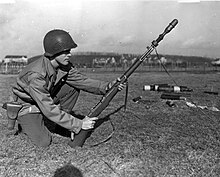Rifle grenade
A rifle grenade is a special grenade that is fired via an attachment on the barrel of a rifle .
technology
Rifle grenades are fired either by means of a device attached to the rifle or by means of a device attached to the grenade itself.
The devices attached to the rifle include the muzzle-mounted shooting cup and the tubular grenade device. Shooting cups hold either the entire grenade or the tapered rear part of the grenade (see picture above). Some shooting cups are drawn to increase the accuracy of the grenades they fire; in this case the grenades usually have correspondingly pre-notched guide bands .
The grenade device is a hollow metal cylinder (see middle picture); the associated rifle grenades have a hollow tail unit that is slipped over the grenade device. In some rifles the flash hider is designed as a grenade device (e.g. HK G3 ), in others the grenade device is a separate muzzle attachment.
Some rifle grenades have a long metal pin that is inserted into the barrel of the rifle (see picture below). In this case the grenade can be fired without any additional equipment. The rifle grenade is usually powered by a special propellant cartridge that is similar to a blank cartridge but contains a stronger propellant charge . However, certain rifle grenades can also be used with normal ammunition; These grenades either have a hole in the grenade through which the projectile can pass the grenade without damage, or the grenade has an integrated projectile catcher that stops the projectile (e.g. SIMON rifle grenade ).
A special sight is usually used to aim the rifle grenade. This can be attached to the rifle as a separate device, or it can be an internal component of the rifle, the launcher or the grenade.
Originally, HE shells and fragmentation grenades were used, later smoke, gas, flare and signal grenades were added. Shaped charge grenades are used for anti-tank defense. Some rifle grenades can also be used as hand grenades , while others are hand grenades (for example the Mills grenade ), which can also be used as rifle grenades with additional parts.
Rifle grenades usually have an impact fuse; The hand grenades that can be used as rifle grenades usually have a time fuse.
Modern rifle grenades can be fired indirectly up to a distance of around 400 meters; however, this only applies to grenades with a surface effect. In direct straightening, distances of up to 150 meters can be achieved. Anti-tank rifle grenades have an even shorter effective range (around 50 to 100 meters) because they have to hit their target directly to be effective.
In the French rifle grenade VB 1916, the shooting cup was placed directly on the barrel. Since the grenade was drilled through in the longitudinal axis, the 8 × 50 mm R Lebel ammunition could be used with a projectile. It was used with the Lebel Model 1886 rifles and the Berthier rifle .
history


Although there were shooting cups for rifle grenades as early as the 17th century, from which the then common ball hand grenades could be fired with fuses, the rifle grenade was only used more widely in the trench warfare of the First World War . Rifle grenades with a handle or a shooting cup were used here. The rifles with which rifle grenades were fired were often used in shooting frames and served as makeshift grenade launchers.
During the Second World War , development moved away from the rifle grenade with a stick. The separate grenade device was now used more widely, especially for anti-tank grenades.
After the Second World War, rifles were used in which the flash hider could serve as a grenade device. The importance of the rifle grenade steadily declined as grenade rifles and shoulder-mounted anti-tank weapons became available.
Nowadays, rifle grenades are still used by the police to fire irritant gas grenades over large distances against crowds of people.
disadvantage
A rifle grenade launched by a rifle causes a strong recoil. Some rifles, which are primarily used to fire rifle grenades, are therefore provided with a rubber recoil pad on the butt cap.
With some rifle grenades, the recoil is so strong that it is hardly possible to shoot it with the normal shoulder stop. These grenades are shot from the hip stop or the rifle butt is clamped under the arm and the trigger is pulled with the thumb.
For long-range shots with rifle grenades, the butt of the rifle is usually placed on the ground; on hard ground, the wooden butt of a rifle can splinter due to the recoil.
The self-loading mechanism of a weapon can adversely affect the range of a rifle grenade, as some of the propellant charge is lost. On the other hand, the higher load can damage the mechanism. With some rifles that use gas pressure for reloading, this mechanism can therefore be switched off; this is often done by opening the integrated grenade sight.
The accuracy of most rifle grenades is limited due to the short guide in the shooting cup or on the grenade device, which makes their use particularly difficult for anti-tank systems.
With many grenade launchers, the grenade has to be fired with a special propellant cartridge. If normal cartridges are mistakenly used, there is a risk that the shooter will either be seriously wounded or even killed.
See also
literature
- Ilya Shaydurov: Russian close combat equipment: types, technology . 1st edition. Motorbuch, 2017, ISBN 978-3-613-03974-2 , pp. 68 ff .
- Fritz Hahn: Weapons and Secret Weapons of the German Army 1933-1945 , Bernard & Graefe Verlag, Bonn 1992, ISBN 3-7637-5915-8
- Michael Heidler: German rifle grenades and their launching devices until 1945 , Volume 9 of essays on history + technology , Sünkel Verlag, 2003, ISBN 9783930060092
- Michael Heidler: German rifle grenades and rifle grenade devices until 1945 , Verlag VDM Heinz Nickel, 2010, ISBN 9783866190511




